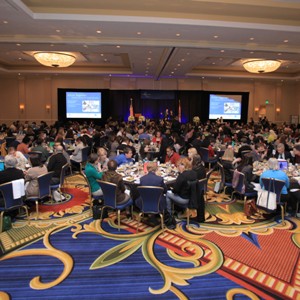
Kyle’s story demonstrates the very real consequences of poorly run and poorly coordinated programs that fail to meet young people’s needs after school, said Nancy Devine, director of learning and enrichment for The Wallace Foundation, which has funded research into after-school programming for the last decade.
“If you really want to know why we should build systems, it’s because too many of our young children are in crisis,” Devine said. “Working together makes a difference. Quality makes a difference.”
Devine spoke Friday at a national conference organized by five youth-serving organizations, including the Wallace Foundation, to encourage coordination and information-sharing on after-school programming between agencies, nonprofits and community groups within the same jurisdiction.
Nearly 400 people from 57 cities are in Baltimore for the conference, organized into city teams representing multiple stakeholders from their area. The foundation encouraged attendees to register as area teams, rather than individuals, as a way to build wide-ranging support for changes when attendees return home, said Lucas Held, a foundation spokesman.
City officials and after-school program administrators at the conference this morning urged their counterparts to invest in better data collection to measure and improve outcomes for young people, build community goodwill and attract diverse sources of funding.
Indicators of after-school program success would include improved attendance rates for regular school, improved behavior at school, improved academic achievement, and reduced involvement with crime, speakers said.
But collecting and aggregating such data isn’t enough to measure and improve upon after-school programs. Investing in public relations is another critical part of making programs successful by attracting new donors, said Carla Sanger, president and CEO of the LA’s BEST after-school enrichment program in southern California.
“My family felt that to be successful, first, you had to do a damn good job, second, you had to do a damn good job, and third, you had to let people know you were doing a damn good job,” Sanger said.
The first staff member Sanger hired for her fledgling after-school initiative in the 1980s was a public relations director, she said. “The PR director was critical to bringing visibility and ultimately dollars to our program,” Sanger said. She encouraged after-school program officials to talk to local politicians, Rotary Clubs, local journalists and other community members to make them aware of program accomplishments.
Having a vision for student success was essential for any after-school program, she said, but, “If you don’t have the resources and funding to keep up with the increasing costs of doing business, you’re not going to get there.”
Sanger also emphasized a balance of enrichment, recreation and education for after-school curricula, saying kids should be able to have fun while learning at the same time.
Jonathan Brice, the school support network officer for Baltimore City Public Schools, underscored Sanger’s point. “If you have to sacrifice fun, you’re not going to have successful programs,” Brice said.
But ultimately, making any after-school program successful comes down to gathering and sharing the right data in order to prove outcomes, and to putting together sustainable sources of funding that draw upon a variety of private and public sources, speakers said.
“Certainly, you need external funding. You do need quantifiable data. I keep coming back to that,” Brice said. “No school superintendent is going to devote time, money and people to something that he or she cannot determine adds value to the bottom line, which is increasing student achievement.”
Photo credit: The Wallace Foundation





























